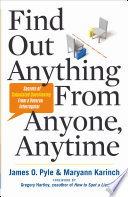

In today's fast-paced world, the ability to gather information is crucial. This book emphasizes that information is power, and the more you know, the better decisions you can make. The author discusses various techniques for effective information gathering, including the use of open-ended questions, active listening, and building rapport. By mastering these techniques, readers can uncover valuable insights that would otherwise remain hidden. The book illustrates this point with real-life examples where individuals successfully navigated complex situations by leveraging their information-gathering skills.
Continue readingOne of the key components of eliciting information from others is the ability to build rapport and establish trust. The author explains that people are more likely to share information when they feel a connection or trust with the person asking. Techniques such as mirroring body language, showing genuine interest, and finding common ground are highlighted as effective strategies. The book provides practical exercises to help readers develop these skills, reinforcing the idea that strong interpersonal relationships are foundational to successful information gathering.
Continue readingAsking the right questions is an art form that can significantly impact the quality of information obtained. The book categorizes questions into open-ended and closed-ended, explaining when to use each type effectively. Open-ended questions encourage deeper conversations and allow for more comprehensive answers, while closed-ended questions can be useful for specific information. The author provides a framework for crafting questions that elicit detailed responses, emphasizing the importance of clarity and context in question formulation.
Continue readingCommunication is not just about words; non-verbal cues play a significant role in how information is conveyed and received. The book delves into the nuances of body language, facial expressions, and tone of voice, illustrating how these elements can enhance or hinder the information-gathering process. Understanding and interpreting non-verbal signals can provide additional context and depth to conversations, allowing readers to become more attuned to what others are truly communicating, even when they are not speaking.
Continue readingBarriers to effective communication can arise from various sources, including cultural differences, personal biases, and emotional states. The author discusses strategies to overcome these barriers, such as being aware of one’s own biases, adapting communication styles to suit different audiences, and practicing empathy. By recognizing and addressing these obstacles, readers can create a more conducive environment for open dialogue, ultimately leading to richer information exchange.
Continue readingIn the digital age, technology plays a pivotal role in how we gather and process information. The book explores various tools and platforms that can aid in information gathering, including social media, databases, and search engines. It emphasizes the importance of critical thinking and discernment when using these tools, as not all information found online is reliable. By leveraging technology effectively, readers can enhance their information-gathering capabilities while being mindful of the quality and credibility of the sources they engage with.
Continue readingThe ultimate goal of mastering information-gathering techniques is to apply them in real-world scenarios. The author provides case studies and practical examples of how individuals have successfully used these skills in various contexts, from job interviews to negotiations and conflict resolution. These applications serve to illustrate the versatility and effectiveness of the techniques discussed throughout the book, encouraging readers to practice and refine their skills in everyday situations.
Continue reading